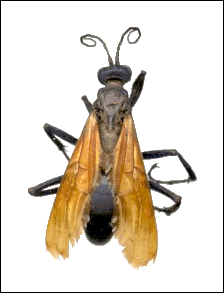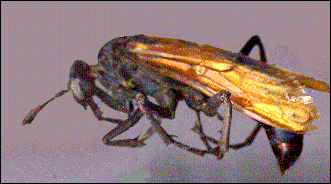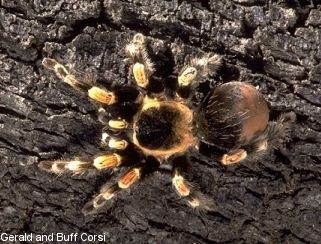
Walking peacefully along the desert floor, a tarantula could meet an unwelcome opponent called a tarantula hawk! It is not a bird, but a large blue-black wasp with orange wings.
Although the wasp is much smaller than the spider, it tries to pick a fight. This is dangerous, because if the tarantula wins, the wasp will be its dinner! But the wasp has a far more diabolical plan. When the spider rears back to strike, its belly is exposed, and the wasp will try to sting it there. If the wasp is successful, the spider will remain alive, but it will be paralyzed. The tarantula hawk buries the spider, laying a single egg on it.
Ah, but the worst is yet to come for the spider! When the larva hatches, it begins to eat the still-living spider. If the tarantula dies, it won't be good food, so the larva eats only the tissues the spider can live without. Later, it will emerge as an adult wasp, seeking tarantulas to feed its own young.
Look for these wasps around mesquite shrub and soapberry trees that are
blooming.  You will see one
of the most colorful insects in the Chihuahuan Desert.
You will see one
of the most colorful insects in the Chihuahuan Desert.
Listen to the Audio (mp3 format) as recorded by KTEP, Public Radio for the Southwest.
Contributor: William Mackay, Laboratory for Environmental Biology, Centennial Museum, University of Texas at El Paso.
Desert Diary is a joint production of the Centennial Museum and KTEP Public Radio at the University of Texas at El Paso.


Tarantula hawk.

Tarantula (Brachypelma smithi). Photograph by Gerald and Buff Corsi, © California Academy of Sciences, 1999. Photographed in Contra Costa County, CA, United States.
Durden, C. (compiler). 1999. Learn About Texas Insects: A Learning and Activity Book, Texas Parks and Wildlife, Austin, 60 pp.